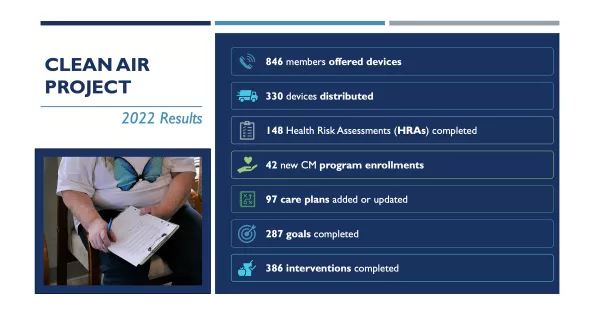Using SDoH data to serve at-risk populations in times of crisis
The devastating effects wildfires and other natural disasters occurring around the country are impacting millions of Americans’ health each year. While poor air quality affects everyone, often, the groups most affected are the ones already suffering with chronic disease or social determinants of health (SDoH) factors such as housing or transportation insecurity.
In Arcadia’s Byte-Sized Insights, Dr. Douglas Carr, Chief Medical Officer at Umpqua Health and Robin Traver, Vice President of Clinical Operations at Umpqua Health shared with Dr. Rich Parker, Chief Medical Officer at Arcadia how they gathered and then used SDoH data to distribute critically important air purifiers to members most at-risk for severe reactions to poor air quality during recent Oregon wildfires.
Prioritizing social determinants of health

Umpqua Health supports 35,000 members in rural Douglas County, OR, an area that extends from Crater Lake to the Pacific Ocean. Umpqua is a payer and also coordinates care within its region. The care coordination team includes nurses, social workers, mental health professionals, a pharmacist, and community health workers.
“A lot of what we do is driven by our health risk assessment in Arcadia’s platform,” said Traver.
Through the health risk assessment, Umpqua can identify members' physical and mental health needs as well as SDoH needs to create a care plan.
Umpqua uses a health equity lens in everything it does, so it often addresses SDoH challenges first. It used data to identify the top SDoH categories in Douglas County, which are housing, behavioral and mental health, and healthy behaviors.
“We have the second highest smoking rate in the state of Oregon — 32% of our members smoke — so that is a big risk factor for our community,” said Travers.
Umpqua Health’s Clean Air Project

In recent years, mega-fires in Oregon have burned for several months, making air quality a major issue for long periods of time. To combat the impacts of the wildfire smoke, in 2022, the Oregon Health Authority was allowed to purchase air purifiers for community care organizations to distribute to members at high risk.
The project was a quick timeline. Using Arcadia’s respiratory risk report, Umpqua Health identified members with asthma, COPD, cardiac conditions or other risk factors. After generating a list of about 850 members to get in contact with, they were able to reach 40% of the list who accepted the offer and received the device.
The outreach function allowed them to quickly send a text message to the identified members, making it a seamless way to facilitate the workflow effectively.
“We also could overlay factors around race, ethnicity, and SOGI data so we could identify those historically marginalized groups and double down, triple down the kind of outreach that we could have to make sure the outcomes, which is the health equity piece, was the same as the dominant culture,” added Dr. Carr.
More opportunities to improve health outcomes

Umpqua didn’t just stop at distributing air purifiers. During the distribution process, it identified members that did not have a complete health risk assessment, which led to more program enrollments, updated care plans, and more interventions completed.
“It was a great opportunity to engage with members and see how else we can help them,” said Traver.
SDoH must be addressed because they create so many problems for healthcare. For example, if a patient’s housing is insecure, they can’t be communicated with, they can’t get to appointments, and it's a downward spiral. Communities look to healthcare to solve these issues and organizations can help by making connections. Umpqua has developed an asset map so that it can easily connect members to the right resources.
“Umpqua has shown us it’s not just healthcare. You’re connecting with resources to work on housing,” said Dr. Parker.
Dr. Carr says in addition to making those types of connections, Umpqua Health attempts to overcome challenges associated with SDoH by giving all members phones to ensure they can communicate with them.
Data versus data analysis
Having data doesn’t do much good if it isn’t actionable. Strong data analysis allows organizations to activate creative solutions quickly. As more and more parts of the country are affected by wildfires and other disasters, quick action is necessary to support the needs of the community and good health outcomes.
Watch more Byte-Sized Insights or request a demo to see how we can put your data to work, together.
